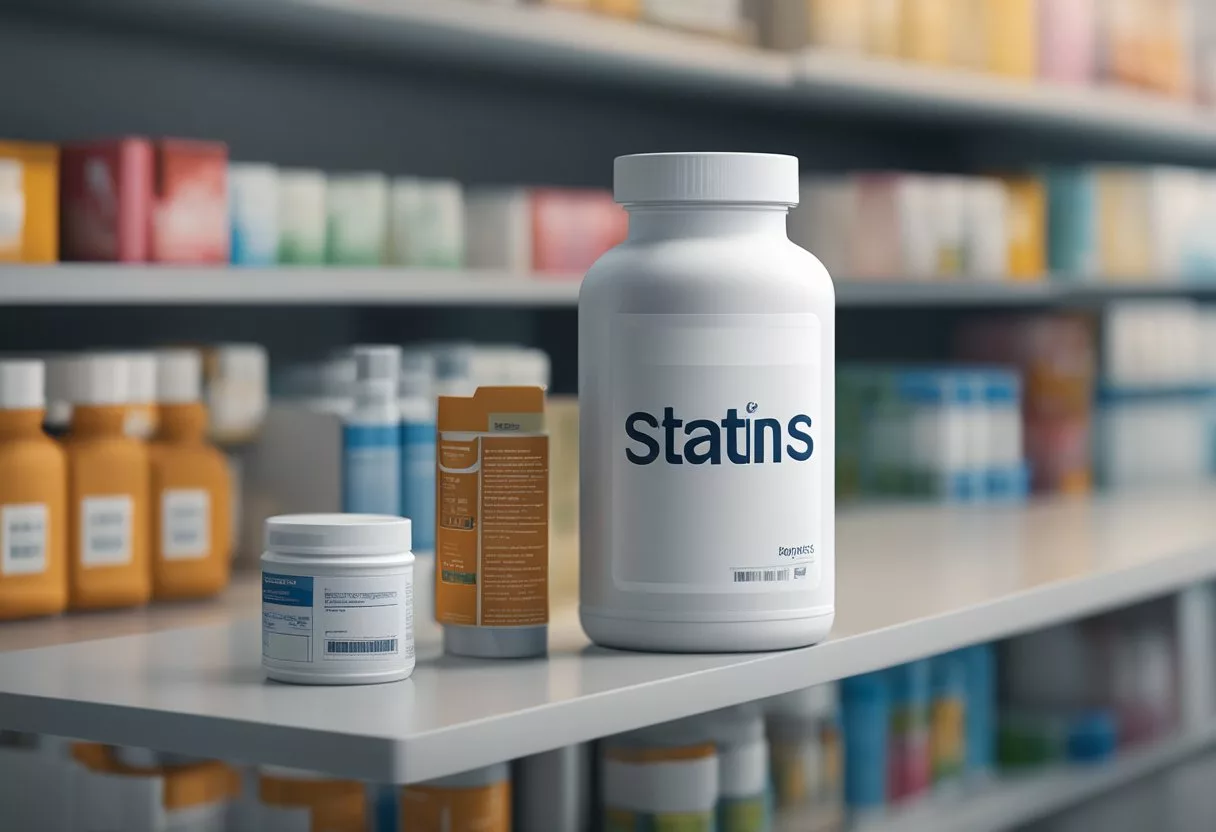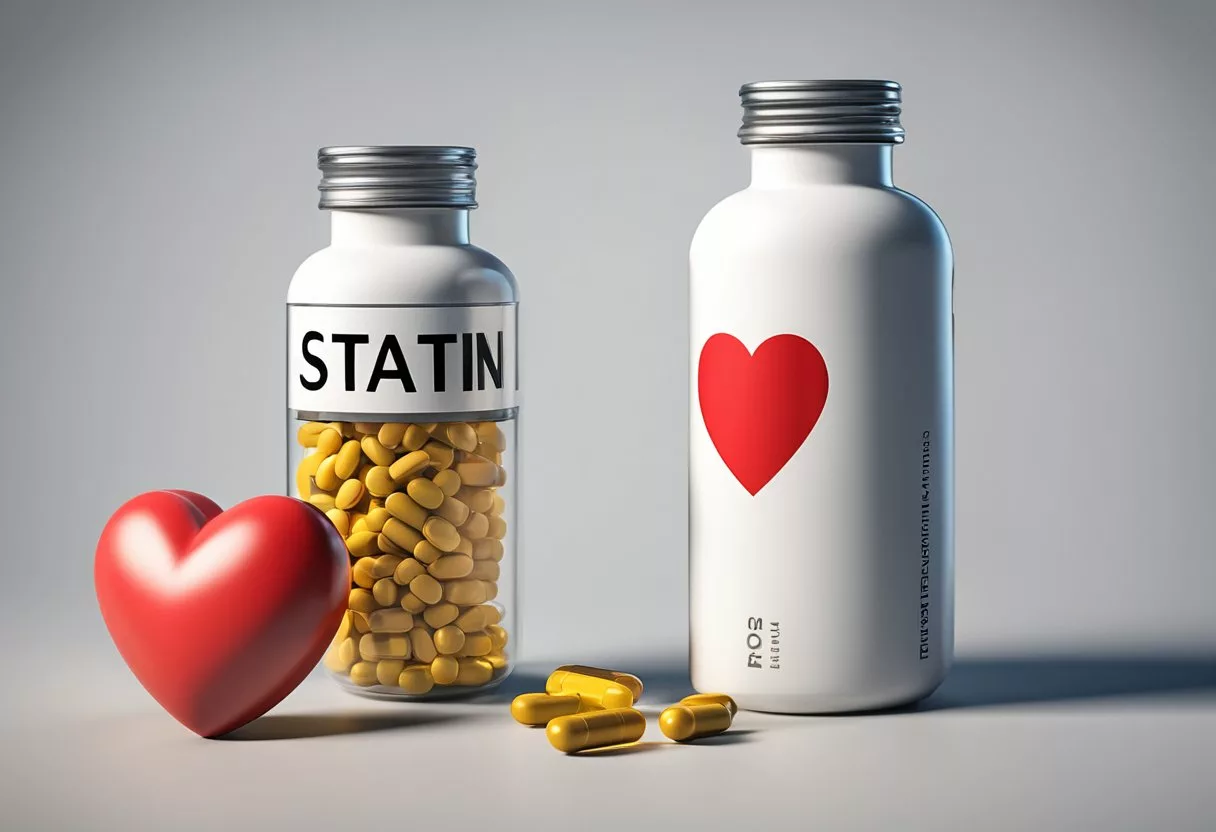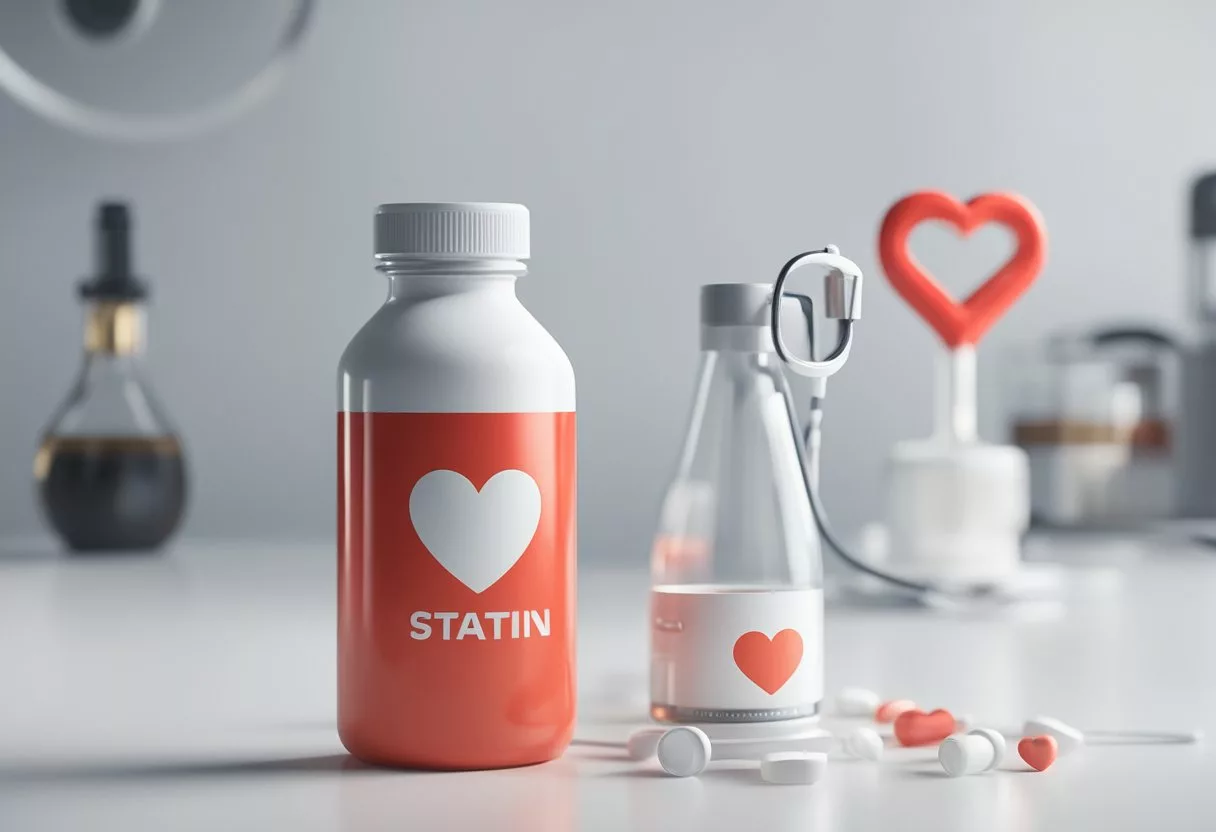Cardiovascular disease (CVD) remains the leading cause of death in the United States, driving the need for effective preventive measures.
Statin therapy has shown significant benefits in reducing the risk of cardiovascular events in both primary and secondary prevention settings.
Statins work by lowering cholesterol levels, thereby decreasing the chances of heart attacks and strokes.

For individuals with or without clinical symptoms of ASCVD, statins have proven to be a powerful tool in improving long-term health outcomes.
High-intensity statin use can prevent up to 71% of premature ASCVD events among younger adults if started early and continued over many years.
This statistic highlights the importance of early intervention and consistent medication adherence for optimal results.
Patients and clinicians must weigh the benefits and potential side effects of statin therapy.
While the reduction in all-cause mortality and prevention of severe cardiovascular events are compelling reasons to consider statins, understanding individual risk factors and health conditions plays a crucial role in therapy decisions.
Key Takeaways
- Statin therapy reduces cardiovascular disease risks.
- Early and consistent statin use is highly beneficial.
- Weighing benefits and risks is essential for individual patients.
Understanding Cardiovascular Disease
Cardiovascular disease (CVD) remains a leading cause of death and disability. It involves numerous conditions that affect the heart and blood vessels, and its impact on public health is significant.
Epidemiology and Impact on Health
Cardiovascular disease is a major health issue worldwide. In the United States, it is the leading cause of death, responsible for one in every four deaths. The American Heart Association reports that in 2022, over 92 million American adults had some form of CVD.
CVD’s burden includes high rates of mortality and morbidity. It significantly increases the risk of heart attacks and strokes, which can lead to long-term disability. The economic impact is also substantial, with high healthcare costs and lost productivity due to illness and death.
Pathophysiology of Cardiovascular Disease
The development of cardiovascular disease involves complex processes.
Atherosclerosis, the buildup of fats and cholesterol in artery walls, is a primary cause. This buildup narrows arteries and restricts blood flow, potentially leading to heart attacks and strokes.
Risk factors, such as hypertension, high cholesterol, diabetes, and smoking, exacerbate these processes.
These factors contribute to inflammation and damage the endothelium, the inner lining of blood vessels. Over time, plaque buildup can rupture, causing blood clots that obstruct blood flow and result in serious cardiovascular events.
Primary and Secondary Prevention
Preventing cardiovascular disease involves both primary and secondary strategies.
Primary prevention aims to reduce risk in individuals without CVD. This includes lifestyle changes like a healthy diet, regular exercise, and quitting smoking.
Statin therapy is also recommended for adults with high cholesterol or other risk factors, as outlined by the US Preventive Services Task Force.
Secondary prevention focuses on preventing recurrence in those already diagnosed with CVD.
This involves stricter risk factor control, medications such as blood pressure-lowering drugs, and continued statin therapy to reduce cholesterol levels.
The American College of Cardiology recommends thorough management plans tailored to individual patient needs.
Statin Therapy: An Overview
Statin therapy is widely used for reducing low-density lipoprotein cholesterol (LDL-C) levels to prevent cardiovascular diseases. This section covers how statins work, when they should be used, and the different types available.
Mechanism of Action
Statins, also known as Hydroxymethylglutaryl-CoA Reductase Inhibitors, block an enzyme in the liver responsible for producing cholesterol.
This enzyme is HMG-CoA reductase. By inhibiting this enzyme, statins decrease the production of cholesterol.
This leads to a reduction in LDL-C levels in the blood, lowering the risk of atherosclerosis and heart disease.
This process can improve blood vessel function and reduce inflammation, which also contributes to cardiovascular benefits.
Clinical Indications and Guidelines
Statins are prescribed for patients with high LDL-C levels or existing cardiovascular conditions.
For those with a 10-year cardiovascular disease risk of 10% or more, statins are recommended. Adults with risk factors such as diabetes, hypertension, or smoking may also benefit.
Guidelines suggest starting therapy with a statin after discussing the risks and benefits with a healthcare provider.
Patients with a 7.5% to less than 10% 10-year risk may consider statin therapy selectively.
Categories of Statins
Statins are categorized into different types based on their potency and half-life:
- High-Intensity Statins: Include atorvastatin and rosuvastatin. These are used for significant LDL-C reduction.
- Moderate-Intensity Statins: Examples are simvastatin and pravastatin, which lower LDL-C by 30-50%.
- Low-Intensity Statins: These include fluvastatin, typically used for those at a lower risk of cardiovascular events.
Each category provides different levels of cholesterol-lowering benefits, allowing tailored treatment to individual patient needs.
Risk Factors and Statin Indications
Statin therapy is recommended for individuals with specific risk factors associated with a higher chance of developing cardiovascular disease. It is important to assess these risk factors and utilize screening tools to determine the need for statin therapy effectively.
ASCVD Risk Factors
Atherosclerotic cardiovascular disease (ASCVD) risk factors play a crucial role in determining whether statin therapy is necessary.
Diabetes, smoking, hypertension, and high cholesterol levels are significant contributors to cardiovascular risk.
Diabetes increases the risk of ASCVD due to elevated blood sugar levels damaging the blood vessels.
Smoking accelerates the build-up of plaque in arteries, increasing the likelihood of heart attacks and strokes.
Hypertension or high blood pressure strains the heart and blood vessels, leading to potential cardiovascular events.
Additionally, individuals with high levels of LDL (low-density lipoprotein) cholesterol or familial hypercholesterolemia (a genetic disorder) are at higher risk.
Risk enhancers such as chronic kidney disease, inflammatory diseases, and history of premature menopause in women can further justify statin therapy.
Risk Estimation and Screening Tools
Healthcare providers use specific tools to evaluate a person’s risk for cardiovascular disease.
The Pooled Cohort Equations is one such tool that estimates the 10-year risk of a cardiovascular event.
It considers age, gender, cholesterol levels, blood pressure, smoking status, and diabetes presence.
For patients 40-75 years old without diabetes and LDL-C levels between 70 mg/dL and 189 mg/dL, an estimated 10-year ASCVD risk of 7.5% to 19.9% might require statin therapy.
Clinicians recommend statins for those with a 10-year CVD risk of 10% or greater, especially when combined with additional risk factors like smoking or dyslipidemia.
Documenting these risks through comprehensive screening promotes targeted and effective prevention of cardiovascular disease.
Statins in Primary Prevention

Statins are widely used to prevent the onset of cardiovascular diseases in adults with specific risk factors. They help to lower cholesterol levels and reduce the risk of heart events.
Evidence and Guidelines
Several key studies and guidelines emphasize the importance of statins for primary prevention.
According to the US Preventive Services Task Force, adults aged 40-75 with one or more cardiovascular risk factors should start statin therapy if they have a 10-year CVD risk of 10% or higher.
The 2019 ACC/AHA guidelines recommend assessing the 10-year risk of atherosclerotic cardiovascular disease (ASCVD) before starting statins.
It’s crucial for clinicians to discuss risks and benefits with patients. Statins can lower the risk of heart attacks and strokes in these individuals.
Patient Populations Benefiting the Most
Certain adults benefit significantly from statin therapy. People aged 40-75 with diabetes mellitus are considered high-risk and are prime candidates for statins. Those with elevated low-density lipoprotein cholesterol (LDL-C) levels (≥190 mg/dL) should also consider this medication.
Adults without diabetes but with a substantial 10-year CVD risk also see benefits. Clinicians might selectively offer statins to those with a lower estimated risk (7.5% to less than 10%).
Statins support primary prevention by reducing LDL cholesterol. This helps prevent plaque buildup in arteries and lowers the risks of severe heart conditions. By targeting those at significant risk, statins play a vital role in cardiovascular health management.
Statins in Secondary Prevention
Statins are critical in reducing the recurrence of cardiovascular events in patients with established atherosclerotic cardiovascular disease (ASCVD). This section explores significant evidence and guidelines, as well as risk stratification and therapy adjustment for individuals undergoing secondary prevention.
Evidence and Guidelines
Statins decrease the risk of recurrent events such as myocardial infarction and stroke. Various guidelines advocate high-intensity statins for secondary prevention, which can reduce low-density lipoprotein cholesterol (LDL-C) by over 50%. According to a study, consistent use of high-intensity statins is recommended to achieve substantial LDL-C reduction.
Moreover, additional recommendations suggest using alternatives like ezetimibe if LDL-C levels exceed 70 mg/dL, despite maximum statin doses. If LDL-C remains high, adding a PCSK9 inhibitor might be considered.
Risk Stratification and Therapy Adjustment
Risk stratification is essential in personalizing therapy. Patients with a history of myocardial infarction or stroke require more intensive treatments. High-risk individuals are those who have multiple ASCVD events or associated conditions like diabetes or chronic kidney disease.
Therapy adjustment involves periodically monitoring lipid levels and side effects. For very high-risk patients, guidelines recommend initial high-intensity statin therapy. If goals are not met, adjustments such as increasing statin dosage or adding medications like ezetimibe or PCSK9 inhibitors become necessary.
References to cohort studies underscore the trend of increasing high-intensity statin use, from 25.0% to 49.2%, highlighting its importance in secondary prevention (JAMA Network). Accurate risk assessment and tailored therapy adjustments are crucial to optimizing patient outcomes.
Efficacy and Benefits of Statin Use

Statin therapy provides significant benefits in reducing cardiovascular events and improving mortality rates, especially for patients with cardiovascular disease.
Reduction in Cardiovascular Events
Statins are effective in reducing the risk of cardiovascular events such as heart attacks and strokes. They lower levels of low-density lipoprotein (LDL) cholesterol, which is a major risk factor for cardiovascular disease.
Clinical trials have shown that patients taking statins experienced fewer cardiovascular events compared to those who did not take the medication. According to the American College of Cardiology, the benefits are consistent across different age groups, even those over 70 years old.
For people with other risk factors such as high blood pressure, diabetes, or smoking, statins can significantly reduce the likelihood of a cardiovascular event. The effects are observed regardless of how elevated the patient’s lipid levels are.
Impact on Mortality Rates
Statin therapy is also associated with a reduction in both all-cause mortality and cardiovascular mortality. By lowering LDL cholesterol, statins help to prevent the buildup of plaque in the arteries, thus reducing complications that can lead to death.
Several randomized clinical trials have provided evidence that statin use decreases the risk of death from cardiovascular causes. Recommendations from the US Preventive Services Task Force emphasize the importance of statins in prolonging life, particularly in high-risk patients.
Patients with a high 10-year risk of cardiovascular disease show the most benefit. Studies demonstrate that consistent statin use lowers deaths from heart disease and other related conditions, contributing to longer and healthier lives for these patients.
Adverse Effects and Harms
Statin therapy is widely used for managing cardiovascular disease, yet it can have several adverse effects. This section includes muscle-related symptoms, metabolic and liver considerations, and strategies for managing side effects.
Muscle-Related Symptoms
Muscle pain is a common complaint among patients on statin therapy. It ranges from mild discomfort to severe muscle damage known as rhabdomyolysis. Rhabdomyolysis is rare but can lead to acute kidney injury (AKI).
Patients often report muscle weakness or cramps. This can impact their physical ability and quality of life. Not all muscle symptoms are due to statins, so it’s vital for clinicians to rule out other causes.
Rosuvastatin, particularly at higher doses, can cause asymptomatic proteinuria and microscopic hematuria, although these effects are typically short-lived and do not affect kidney function.
Metabolic and Liver Considerations
Statins can impact liver function. Elevated liver enzymes are often seen but usually do not indicate severe liver injury. Regular liver function tests are recommended to monitor these changes.
Digestive problems such as nausea, diarrhea, and constipation can also occur. These issues are generally mild and manageable. Statins may slightly increase blood glucose levels, posing a risk to diabetic patients or those at risk for diabetes.
Patients should be informed about these risks. It’s essential to weigh the cardiovascular benefits of statins against the potential for increased blood sugar and liver enzyme levels.
Management of Side Effects
To manage side effects, clinicians may adjust the statin dosage or switch to a different statin. Non-statin lipid-lowering drugs can also be considered for those unable to tolerate statins.
Lifestyle changes, such as diet and exercise, can help mitigate some adverse effects. It’s critical to communicate openly with patients about the potential for side effects and to encourage them to report any new symptoms promptly.
In some cases, supplementing with Coenzyme Q10 might help reduce muscle pain, although evidence is mixed. Monitoring and patient education are key to managing and reducing the harm caused by adverse events in statin therapy.
Special Populations and Considerations

Statin therapy must be tailored to specific populations for optimal effectiveness. Each group, including differences based on gender, age, and race, has unique considerations that affect treatment outcomes. Recognizing these factors can enhance patient care and outcomes.
Gender-Specific Guidelines
Women may have different risk factors for cardiovascular disease compared to men. Hormonal changes, especially during menopause, can affect lipid levels. Guidelines suggest evaluating women of childbearing age carefully before starting statins due to potential risks to fetal development.
In men, the primary concern is typically related to lifestyle factors and the presence of other conditions like hypertension or diabetes. Both genders must have their 10-year ASCVD risk estimated before initiating therapy.
Elderly Patients and Statin Therapy
Elderly patients require careful consideration due to age-related factors. Statin therapy can reduce the risk of major cardiovascular events even in those over 75. However, the potential for adverse effects, such as muscle pain and liver problems, increases with age.
Decisions for statin use in the elderly should weigh the benefits against possible risks. Shared decision-making involving the patient and clinician is crucial for this age group.
Race and Ethnicity Factors
Different races and ethnicities can have varying responses and risk factors for cardiovascular disease. Black persons may have a higher risk of hypertension and diabetes, which affects statin therapy effectiveness. Statin benefits might be more pronounced but require monitoring for muscle-related side effects.
Hispanic adults could exhibit different lipid profiles and higher risks for diabetes. Understanding these dynamics is critical. Family history of premature ASCVD is an important factor to consider in this population, guiding more tailored and precautionary approaches to statin therapy.
Emerging Trends and Novel Therapies

Recent advancements in lipid metabolism research have introduced new methods and drugs to better manage cardiovascular disease. These innovations are critical for patients who do not respond well to traditional statin therapy.
Advanced Lipid Testing
Advanced lipid testing offers a more precise analysis of lipid profiles beyond basic cholesterol measurements. It includes tests such as lipoprotein(a) and apolipoprotein B. These markers provide a detailed risk estimation for cardiovascular events.
Patients with non-traditional risk factors can benefit from this detailed profile. It helps in identifying individuals at high risk who might not show elevated low-density lipoprotein-cholesterol (LDL-C) levels through standard tests. This data allows for a more personalized treatment plan.
New Pharmaceutical Agents
Several novel agents have been developed to target lipid metabolism more effectively. Drugs like PCSK9 inhibitors and icosapent ethyl (IPE) have shown promising results.
These agents work differently from traditional statins and offer additional benefits.
For example, PCSK9 inhibitors lower LDL-C by preventing the degradation of LDL receptors. IPE, derived from omega-3 fatty acids, reduces triglycerides and is beneficial for patients with hypercholesterolemia.
These nonstatins provide options for patients who cannot tolerate statins or need more aggressive lipid lowering.
By targeting new pathways in lipid metabolism, these therapies are designed to offer better cardiovascular outcomes and improve overall health for high-risk populations.
Implementing Statin Therapy

Implementing statin therapy involves making well-informed clinical decisions and ensuring patients are educated and engaged in their treatment. Both aspects are necessary to optimize outcomes and adherence.
Clinical Decision Making
Choosing to start statin therapy involves assessing demographic and clinical characteristics such as age, sex, and existing health conditions.
Clinicians must evaluate the patient’s 10-year risk of cardiovascular disease (CVD) and consider guidelines from bodies like the US Preventive Services Task Force.
For individuals with a higher risk (10% or greater), the need for statins is more pressing. Recognizing these risks helps in determining the intensity of statin therapy required.
Patient preference is also vital in this decision-making process. Shared decision-making models where patient values and preferences are considered can improve adherence and satisfaction.
Engaging patients in the discussion about potential benefits and risks, including the possibility of developing conditions like diabetes, is crucial.
Patient Education and Engagement
Educating patients on why statin therapy is necessary and how it works is critical. This includes explaining how statins lower cholesterol levels and reduce the risk of heart attacks and strokes.
Use simple language and clear visuals if needed. Discuss any possible side effects and how they can manage them.
Engagement is equally important. Encourage patients to actively participate in their treatment plan.
Provide resources such as brochures or credible websites for further reading. Ensure follow-up appointments to monitor progress and address any concerns they have.
This continuous interaction between patient and clinician strengthens the treatment process, enhancing adherence and outcomes for people with CVD.
Future Directions in Statin Research

Future research on statin therapy aims to explore various areas to enhance treatment and outcomes for cardiovascular disease.
Newer Statin Variants
Researchers are investigating newer statin variants that might offer better efficacy and fewer side effects. These innovations could help tailor treatments to individual patient needs.
Genetic Factors
Studying genetic factors may reveal why some patients respond better to statins. Personalized medicine can improve effectiveness and reduce adverse reactions.
Long-Term Safety
Understanding the long-term safety of statins, including potential risks like diabetes, remains crucial. Further studies, including randomized clinical trials, are needed to provide clear guidelines.
Dosage Optimization
Optimizing dosage and identifying the minimum effective dose with the least side effects can help refine treatment protocols. This also includes investigating the benefits of lower-intensity statin therapy.
Meta-Analysis of Existing Data
Conducting meta-analyses of existing data can provide comprehensive insights into the broader impacts of statin use. These analyses can identify trends and gaps in knowledge.
Population-Specific Research
Investigating the effects of statin therapy across different populations, including varied age groups, genders, and ethnicities, can help make recommendations more inclusive.
Combination Therapy
Exploring the potential of combining statins with other medications could reveal new strategies for cardiovascular disease prevention. Researchers are already examining how statins work alongside other treatments.
Real-World Data
Using real-world data from diverse patient sources can validate theoretical models and clinical trial results. This approach could improve understanding and application of statin therapies in everyday practice.
Collaboration and Innovation
Future research will benefit from collaboration across scientific communities. Novel approaches, like machine learning and big data, may unlock new possibilities in statin therapy.
Frequently Asked Questions

Statin therapy is widely used to manage cardiovascular disease and reduce the risk of heart attacks and strokes. The following points discuss guidelines, effectiveness, and specific uses of statins in various patient scenarios.
What are the guidelines for statin use in persons with diabetes?
Persons with diabetes often have an elevated risk of cardiovascular disease due to higher cholesterol levels. The American Heart Association recommends statins for these patients to lower their risk of heart disease and stroke.
Typically, a moderate to high-intensity statin is prescribed based on the individual’s risk factors and medical history.
How does statin therapy contribute to the primary prevention of cardiovascular disease?
Statins lower LDL cholesterol, reducing the likelihood of developing heart disease in at-risk individuals. Testing can help determine the need for statins before major heart or vascular issues arise.
Preventive use is crucial for those with risk factors like high cholesterol or a family history of heart disease.
Which statins are considered most effective in treating coronary artery disease?
Atorvastatin and Rosuvastatin are among the most effective statins for treating coronary artery disease. They can lower LDL cholesterol by at least 50%.
These medications are typically prescribed at higher doses (e.g., Atorvastatin 40-80 mg, Rosuvastatin 20-40 mg) to achieve significant reduction in cholesterol levels.
What role do statins play in the management of patients with cardiovascular disease and diabetes?
Statins are essential for managing patients with both cardiovascular disease and diabetes. They help lower high cholesterol, a common issue in diabetic patients, thereby reducing their risk of heart attacks and strokes.
Combining statins with lifestyle changes like a healthy diet and regular exercise further enhances their benefits.
How are statins utilized for patients with cardiovascular disease according to HEDIS?
According to HEDIS, statins are recommended for patients with cardiovascular disease to manage their cholesterol levels effectively.
Regular monitoring of LDL-C levels ensures the statin dosage is appropriate and effective. Statin therapy is a key aspect of managing cardiovascular health as per the HEDIS guidelines.
What are the current recommendations for statin therapy for primary prevention of cardiovascular disease?
Current recommendations for primary prevention include prescribing statins to individuals with high LDL cholesterol or those at significant risk of cardiovascular events.
Factors such as age, blood pressure, smoking status, and family history of heart disease are considered when deciding on statin therapy.
Regular check-ups and cholesterol monitoring are crucial to ensure the therapy’s success.